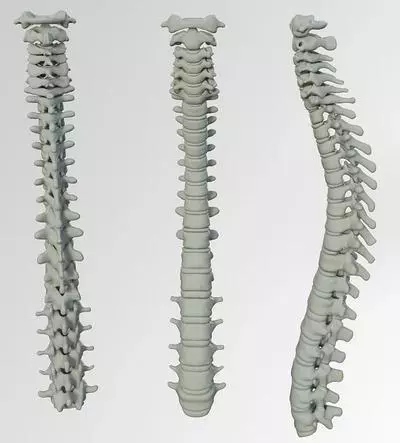What is kyphosis?
The definition: A pathological kyphosis is understood to mean an outwardly convex curvature in the spine. Colloquially, this is referred to as a hunched back. Physiological kyphosis occurs in two places on the spine - on the thoracic vertebrae and in the sacral area.
However, it is disturbing and pathological if it is larger in the thoracic vertebrae area, since the curvature of the spine can lead to considerable impairments. Kyphosis is the opposite of lordosis, which occurs in the lumbar region and is an inward curvature. In the vernacular, the lordosis is referred to as a hollow back.
Possible causes of kyphosis
There are a handful of different causes for the development and different forms of kyphosis. On the one hand it can be congenital as a malformation in the early development phase and on the other hand it forms over the course of life. Reasons for the development are often a bad posture when walking and especially when sitting. Since humans are not - due to evolutionary reasons - used to sitting a lot and moving little, this causes postural defects that are favored by a corresponding muscular insufficiency. Other triggering factors are degenerative diseases such as Bechterew's disease and osteoporosis, trauma in the spinal column area or tumors.
The symptoms of kyphosis
The symptoms of spinal curvature are usually not particularly noticeable for a long time. The curvature of the spine may only gradually become noticeable in the individual if it is more severe. One of the most common symptoms sufferers experience is back pain. Due to the weakened muscles and crooked posture, other parts of the body are overloaded and pain occurs.
There can be a number of other impairments, especially in the case of severe kyphosis, such as breathing difficulties, neurological deficits, numbness in extremities or sleep disorders. Due to the curvature, it is also possible for the spinal cord to be damaged and other organs to be affected if the spinal cord continues to increase.
The preventive measures
As a possible form of prevention, it is important to ensure from an early age - as a parent, for example - that children do not sit too long, get enough exercise and do sports. Likewise, in an office job, attention should be paid to posture when sitting and to regular breaks in which the body is moved.
The diagnosis of a spinal curvature
Often, a doctor can diagnose kyphosis by asking the patient to bend forward at a right angle. With the bent back, it can be seen that it does not bend as usual, but a hump appears. Furthermore, a kyphosis can be diagnosed diagnostically by imaging methods such as an X-ray, a CT or MRI. Doing this is relevant to determine the degree of spinal curvature and to identify or rule out the involvement of other organs.
Conservative therapy
Depending on the degree of impairment, treatment is different. First and foremost, however, there is almost always conservative therapy, which is intended to straighten the curvature of the spine and counteract the muscle deficit with the help of special back orthoses and special physiotherapy. The aim of the gymnastic exercises is to strengthen and balance the back muscles. The curvature of the spine is checked regularly over the years and the general course of the disease is monitored to avoid deterioration.
Surgical intervention
In severe cases, in which the curvature has already progressed beyond 65°, or there is further deterioration despite conservative therapy, surgery is recommended. One of the possible operations is called DDS (dorsal distraction spondylodesis – posterior straightening stabilization), in which minimally invasive screws are inserted into several vertebral bodies on both sides under X-ray control and then two rods are inserted over which the straightening (distraction) takes place.

